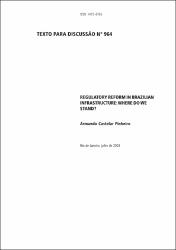Please use this identifier to cite or link to this item:
https://repositorio.ipea.gov.br/handle/11058/2898Full metadata record
| DC Field | Value | Language |
|---|---|---|
| dc.contributor.author | Pinheiro, Armando Castelar | - |
| dc.contributor.other | Rocha, Roberto (Comentários à versão anterior) | - |
| dc.contributor.other | Castro, Newton de (Comentários à versão anterior) | - |
| dc.coverage.spatial | Brasil | pt_BR |
| dc.date.accessioned | 2014-03-28T21:45:29Z | - |
| dc.date.available | 2014-03-28T21:45:29Z | - |
| dc.date.issued | 2003-07 | - |
| dc.identifier.uri | http://repositorio.ipea.gov.br/handle/11058/2898 | - |
| dc.description.abstract | Os principais objetivos do processo de reforma regulatória e privatização no setor de infraestrutura foram: atrair investimentos privados para expandir a capacidade de produção, aumentar a sua eficiência e reduzir a dívida pública, usando as receitas da privatização. Enquanto a evidência disponível sugere que a reforma regulatória (incluindo a privatização) foi bem-sucedida em acelerar o crescimento da produtividade e melhorar as contas públicas, bem menos foi alcançado em termos de elevar os níveis de investimento. O setor de telecomunicações foi a única exceção a essa regra. O que explica o fracasso da privatização e da reforma regulatória em promover um substantivo aumento no investimento em infraestrutura nos demais setores? Ocorreu um erro de diagnóstico, uma implementação malfeita ou faltaram reformas adicionais que dessem suporte a esse processo? O que explica o atípico sucesso no setor de telecomunicações? Que lições extrair desse processo e como usá-las para fazer as necessárias correções de forma a gerar o necessário aumento do investimento em infraestrutura? Este artigo tenta responder a essas questões, revendo e analisando o processo de reforma regulatória nos principais setores de infraestrutura. Em particular, ele examina por que o investimento deixou de aumentar mais significativamente. O artigo discute a reforma regulatória nos setores de telecomunicações, eletricidade, transporte e água e saneamento, e faz recomendações sobre iniciativas que podem ser tomadas para corrigir os problemas apontados no texto. Conclui-se que ainda que muito tenha sido feito e alcançado na reforma da infraestrutura no Brasil, muito resta por fazer. | pt_BR |
| dc.language.iso | en-US | pt_BR |
| dc.publisher | Instituto de Pesquisa Econômica Aplicada (Ipea) | pt_BR |
| dc.title | Regulatory reform in Brazilian infrastructure: where do we stand? | pt_BR |
| dc.title.alternative | Texto para Discussão (TD) 964: Regulatory reform in Brazilian infrastructure: Where do we stand? | pt_BR |
| dc.title.alternative | A reforma regulatória na infraestrutura brasileira: Onde estamos | pt_BR |
| dc.type | Texto para Discussão (TD) | pt_BR |
| dc.rights.holder | Instituto de Pesquisa Econômica Aplicada (Ipea) | pt_BR |
| dc.source.urlsource | www.ipea.gov.br | pt_BR |
| dc.location.country | BR | pt_BR |
| dc.description.physical | 29 p. : il. | pt_BR |
| dc.rights.license | É permitida a reprodução deste texto, desde que obrigatoriamente citada a fonte. Reproduções para fins comerciais são rigorosamente proibidas. | pt_BR |
| dc.subject.keyword | Reforma regulatória | pt_BR |
| dc.subject.keyword | Privatização | pt_BR |
| dc.subject.keyword | Setor de infraestrutura | pt_BR |
| ipea.description.objective | Rever e analisar o processo de reforma regulatória nos principais setores de infraestrutura. | pt_BR |
| ipea.description.additionalinformation | Série monográfica: Texto para Discussão ; 964 | pt_BR |
| ipea.description.additionalinformation | Referências bibliográficas: possui referências bibliográficas | pt_BR |
| ipea.access.type | Acesso Aberto | pt_BR |
| ipea.rights.type | Licença Comum | pt_BR |
| ipea.englishdescription.abstract | The main objectives of regulatory reform and privatization of infrastructure in Brazil were to attract new private investment, increase efficiency and reduce the public debt through the use of privatization revenues. Whereas the evidence suggests that regulatory reform (privatization included) has succeed in fostering productivity growth and improving the fiscal accounts, much less has been accomplished by way of raising investment levels. The telecom sector is apparently the only exception to this rule. What accounts for the failure of privatization and regulatory reform to produce the expected boom in infrastructure investment? Was it an error in diagnosis, faulted implementation or lack of additional supporting reforms? What explains the atypical success observed in telecom? What lessons can be learned from this process and how can these be used to make the necessary corrections so as to produced the needed rise in infrastructure investment? This paper tries to answer these questions, reviewing and analyzing the process of regulatory reform in the main infrastructure sectors. In particular, it examines why has investment failed to expand more significantly. The paper discusses regulatory reform in the telecom, electricity, transportation, and water and sanitation sectors, and makes some recommendations for future action. It concludes that although much has been accomplished in reforming Brazilian infrastructure sectors, at least as much remains to be done. | pt_BR |
| ipea.researchfields | N/A | pt_BR |
| ipea.classification | Administração Pública. Governo. Estado | pt_BR |
| ipea.classification | Saneamento | pt_BR |
| ipea.classification | Terceiro Setor. Serviços. Turismo | pt_BR |
| ipea.classification | Transportes | pt_BR |
| Appears in Collections: | Administração Pública. Governo. Estado: Livros | |
Files in This Item:
| File | Description | Size | Format | |
|---|---|---|---|---|
| TD_964.pdf | 338.24 kB | Adobe PDF |  View/Open |
Items in DSpace are protected by copyright, with all rights reserved, unless otherwise indicated.

